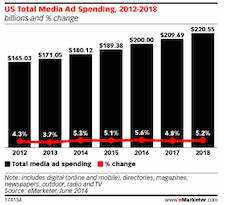There was a double dose of good news in eMarketer’s mid-year ad forecast released today. Ad spending will grow more than 5 percent in 2014 for the first time in 10 years. And the mobile ad boom shows no sign of plateauing with 83 percent growth over 2013 expected.
Digital giants like Facebook and Google continue to dominate the category (together more than 50 percent), while newspapers and magazine struggle to offer competitive ad buys on their mobile products.
The Newspaper Association of America’s revenue report for 2013, released in April, found that mobile advertising had grown 77 percent for the year but still accounted for less than 1 percent of total revenue. By contrast, as Facebook reported its first quarter earnings the same month, it said mobile had grown to 59 percent of its total ad revenue.
A newspaper publisher friend summarized the state of play in his industry this way — “2013 will be remembered as the year when mobile went from infinitesimal to insignificant.”
Doing better in 2014 remains a high priority for many newspapers, but more bumps in an already bumpy road are foreseeable.
The American Press Institute held a summit on mobile this spring and found that detailed personalized data is the key to sales. That is a great strength of Google and Facebook as the digital giants continue to invest heavily to stay ahead of competitors
The creative side of effective mobile advertising is a work in progress for marketers. The consensus seems to be that banners do not work well on smart phones and tablets and that video, GIFs and other entertainment along with location-specific messages are the better match to how customers use the devices.
The right sort of sponsored content/native advertising also fits with mobile, especially if it is the sort of thing users will share on social media.
In short, these are characteristics of the new generation of content sites like BuzzFeed (which does not take banners) but relatively unfamiliar to legacy operations which do.
Mobile news content is also in early stages of development except at the largest organizations like the Wall Street Journal, New York Times, Washington Post and Boston Globe. They have put money into iterative improvement of apps that both display well on the smaller smartphone screen and are tailored to quick, on-the-move consumption.
My own hunch is that getting video right and getting stronger mobile ad performance will go hand in hand for news sites — challenging and frustratingly slow work but hardly impossible.
If the eMarketer forecast is correct, the imperative will only intensify. The research firm sees mobile advertising revenues passing the total ad revenues for newspapers this year and more than tripling them by 2018.









Comments